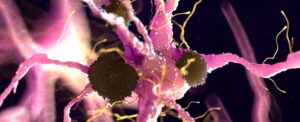
New research reveals that on Saturn’s largest moon, Titan, certain chemicals can combine in ways that defy traditional chemistry principles observed on Earth. This groundbreaking study, conducted by a team from NASA and Chalmers University in Sweden, suggests that the ultra-cold conditions present on Titan allow for chemical interactions that were previously thought to be impossible.
Located approximately 880 million miles from Earth, Titan is renowned for its hazy orange atmosphere and surface features that include lakes and dunes. Scientists are particularly interested in Titan because it resembles early Earth, offering insights into the chemical processes that may have led to the emergence of life on our planet.
A key focus of the research was the interaction between three primary substances found on Titan: methane, ethane, and hydrogen cyanide. Under typical conditions on Earth, hydrogen cyanide—a highly polar molecule—does not mix with nonpolar molecules like methane and ethane, similar to the way oil and water do not blend. However, this new study indicates that at temperatures close to -300 degrees Fahrenheit—comparable to those on Titan—these molecules can form unique crystal structures together.
Defying Chemistry’s Rules
According to Martin Rahm, a chemistry professor at Chalmers and coauthor of the study published in the Proceedings of the National Academy of Sciences, the findings challenge a long-standing chemistry principle known as polarity. This principle states that polar molecules typically dissolve in polar solvents, while nonpolar substances dissolve in nonpolar solvents. Rahm explained, “Like dissolves like,” highlighting the unexpected nature of this discovery.
NASA’s Cassini spacecraft, which studied Titan and its features, originally prompted scientists to explore the potential interactions of hydrogen cyanide with methane and ethane. Utilizing laser spectroscopy, the researchers observed that while the individual chemicals remained unchanged, they discovered an intriguing result: the formation of new kinds of crystals that integrated hydrogen cyanide with the nonpolar substances.
This interaction is significant for astrobiologists. Hydrogen cyanide is believed to be a crucial component in the synthesis of amino acids and nucleobases, the fundamental building blocks of proteins and DNA. Rahm noted, “Our work contributes insights into chemistry before the emergence of life and how it might proceed in extreme, inhospitable environments.”
Implications for Future Exploration
Titan’s unique environment, with its cold atmosphere rich in nitrogen and methane, may simulate conditions on early Earth. It is also the only other known world in the solar system with active weather systems, albeit based on methane rather than water. Titan’s lakes and seas, filled with methane and ethane, undergo a cycle of precipitation that reshapes its landscape in ways reminiscent of Earth’s water cycle.
The potential for life-sustaining chemistry on Titan has driven the planning of NASA’s $3.35 billion Dragonfly mission, set to launch in July 2028. This mission aims to explore Titan’s surface and investigate the possible existence of a subsurface ocean of liquid water, which could further support the conditions necessary for life.
The Chalmers team employed advanced computer simulations to explore various molecular combinations, confirming that organic compounds can integrate into hydrogen cyanide’s crystal structure to form “co-crystals.” The consistency of these findings with laboratory results from NASA suggests that such chemical interactions are likely occurring on Titan.
Rahm concluded, “This is a prime example of how traditional boundaries in chemistry can be challenged, showing that universally accepted rules do not always apply.” As research continues, Titan remains a focal point for understanding the origins of life and the possibilities of chemistry in extreme environments throughout the universe.






